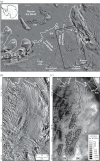Recent advances in understanding Antarctic subglacial lakes and hydrology
- PMID: 26667914
- PMCID: PMC4685968
- DOI: 10.1098/rsta.2014.0306
Recent advances in understanding Antarctic subglacial lakes and hydrology
Abstract
It is now well documented that over 400 subglacial lakes exist across the bed of the Antarctic Ice Sheet. They comprise a variety of sizes and volumes (from the approx. 250 km long Lake Vostok to bodies of water less than 1 km in length), relate to a number of discrete topographic settings (from those contained within valleys to lakes that reside in broad flat terrain) and exhibit a range of dynamic behaviours (from 'active' lakes that periodically outburst some or all of their water to those isolated hydrologically for millions of years). Here we critique recent advances in our understanding of subglacial lakes, in particular since the last inventory in 2012. We show that within 3 years our knowledge of the hydrological processes at the ice-sheet base has advanced considerably. We describe evidence for further 'active' subglacial lakes, based on satellite observation of ice-surface changes, and discuss why detection of many 'active' lakes is not resolved in traditional radio-echo sounding methods. We go on to review evidence for large-scale subglacial water flow in Antarctica, including the discovery of ancient channels developed by former hydrological processes. We end by predicting areas where future discoveries may be possible, including the detection, measurement and significance of groundwater (i.e. water held beneath the ice-bed interface).
Keywords: Antarctica; basal processes; ice flow; ice sheet.
© 2015 The Authors.
Figures





References
-
- Robin G de Q, Evans S, Bailey JT. 1969. Interpretation of radio echo sounding in polar ice sheets. Phil. Trans. R. Soc. Lond. A 265, 437–505. (10.1098/rsta.1969.0063) - DOI
-
- Turchetti S, Dean K, Naylor S, Siegert M. 2008. Accidents and opportunities: a history of the radio echo sounding (RES) of Antarctica, 1958–1979. Br. J. Hist. Sci. 41, 417–444. (10.1017/S0007087408000903) - DOI
-
- Oswald GKA, Robin G de Q. 1973. Lakes beneath the Antarctic Ice Sheet. Nature 245, 251–254. (10.1038/245251a0) - DOI
-
- Robin G de Q, Drewry DJ, Meldrum DT. 1977. International studies of ice sheet and bedrock. Phil. Trans. R. Soc. Lond. A 279, 185–196. (10.1098/rstb.1977.0081) - DOI
-
- Shreve RL. 1972. Movement of water in glaciers. J. Glaciol. 11, 205–214.
Publication types
LinkOut - more resources
Full Text Sources
Other Literature Sources
